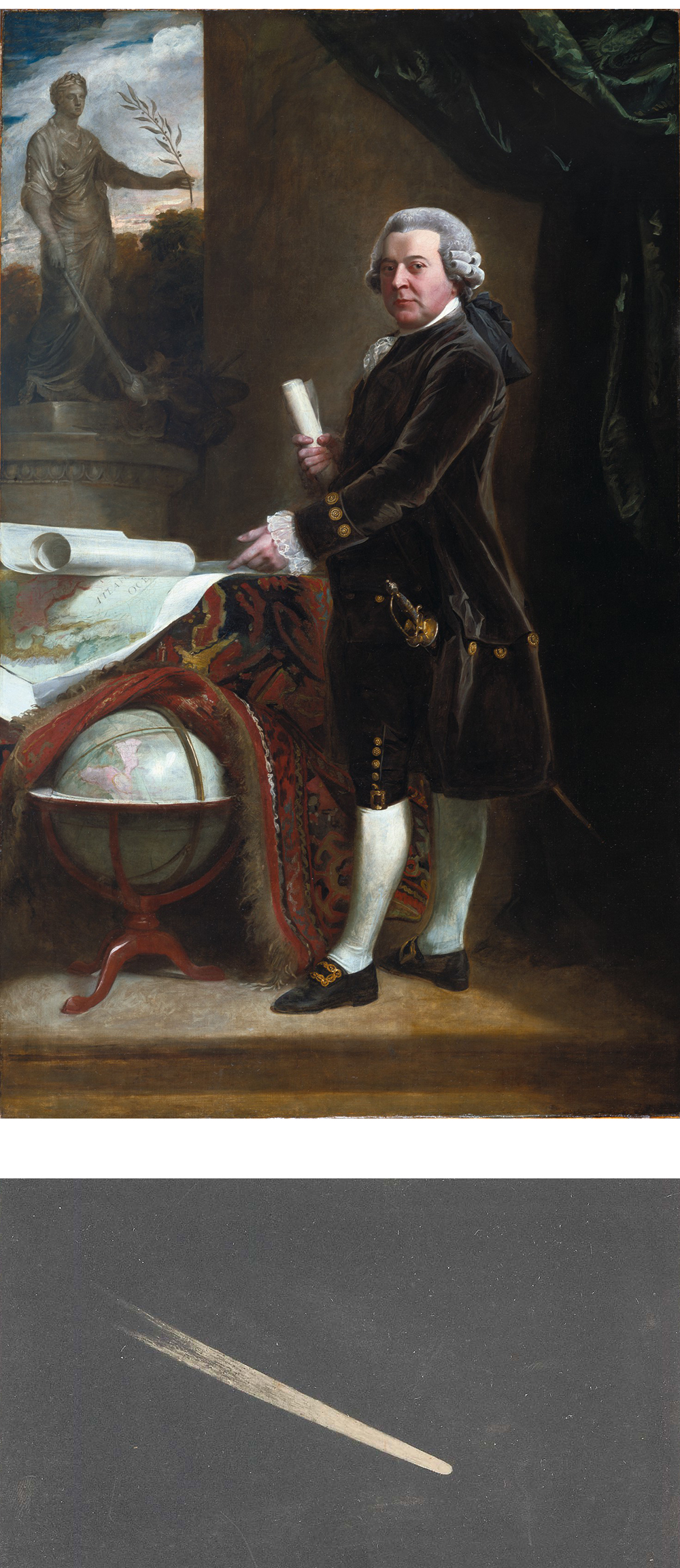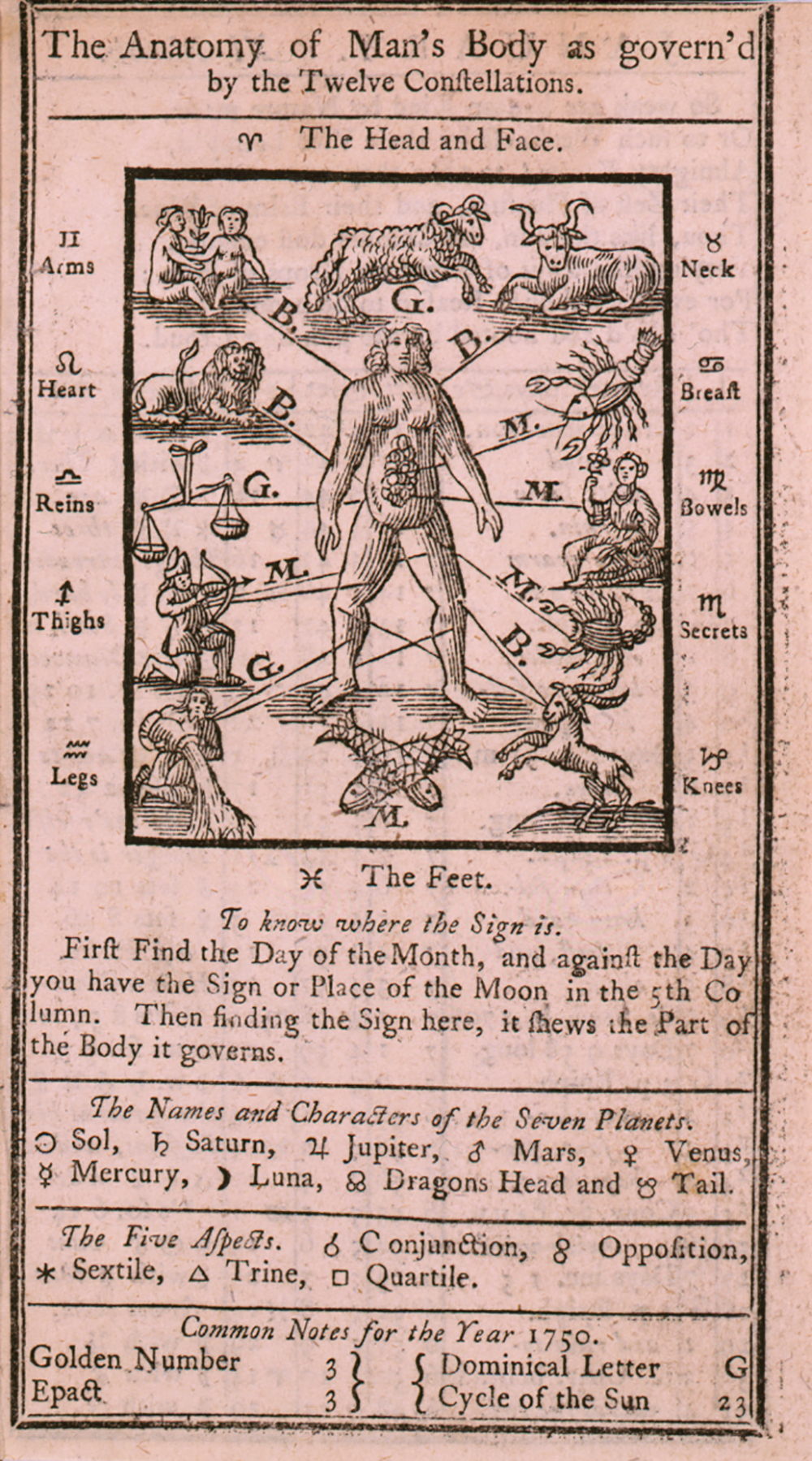
Constellation, by Helen Gerardia, 1956. Smithsonian American Art Museum, gift of Samuel Sumner Goldberg, 1977.
The month he was to be sworn in as the first vice president of the United States, John Adams expected to see a comet. In fact, Adams helped to pay for a publication announcing the celestial appearance, an auspicious astronomical event for the first month of the new federal government.
Since the classical era, comets had been imagined as ill omens for rulers. Plutarch linked the appearance of a comet to the death of Julius Caesar, and William Shakespeare would invoke this association in the sixteenth century when he wrote a play dramatizing Caesar’s assassination. But while the traditional link between the appearance of comets and the deaths of kings had not changed by the late eighteenth century, the ultimate meaning of that association had changed entirely. Revolutions and rebellions had taken on very different associations by this time, and so comets had likewise come to embody new possibilities.
If comets augured the deaths of kings, perhaps they equally augured the lives of republics. Perhaps the appearance of a visible comet streaking across the sky as a new president and vice president were inaugurated would bode well for the young, revolutionary nation. There was only one problem: the comet never appeared.

Adams likely learned about the comet that never was from a series of newspaper advertisements appearing throughout Massachusetts in 1788 and 1789. An astronomer and war veteran named Bartholomew Burges was hoping to publish his cometary prediction, accompanied by a foldout chart that was probably the first accurate-to-scale diagram of a cometary orbit to be published in North America. Adams not only subscribed to the publication but invited the amateur astronomer to his home in Braintree. It was there that Adams expressed interest in Burges’ other area of expertise—Asia. Burges described this meeting in a letter to Adams a little more than a year later, writing, “On your understanding that I had been some many years in the East Indies, your Excellency was pleas’d to intimate that you would present to your friends in Congress a memorial if I prepar’d one pointing out the eligibility of the Americans establishing factories in the East Indies and of striking up commercial treaties with the Indostan, and other Asiatic powers.”
Burges would receive sporadic support from the vice president, including an introduction to George Washington. In many ways, this is unsurprising. Burges embodied a set of interlocking possibilities. As an experienced navigator, he might produce charts and open a school to train sailors in the American commercial fleet. As a merchant seaman with genuine knowledge of the East Indies, Burges might contribute to the new nation’s mercantile ambitions in Asia. The number of U.S. merchant vessels reaching Canton, for instance, grew more than thirtyfold between 1784 and 1800. And, indeed, Burges would go on to write a book about Asia for American traders, copies of which were purchased by both Washington and Adams. Finally, Burges’ calculation of astronomical events coinciding with national events might lend credence to the dream of a stable, revolutionary nation—a paradoxical political formation if ever there was one.
Yet the disorganized patronage model of eighteenth-century natural philosophy and plain bad luck ruined these possibilities. With Adams’ assistance, Burges found backers to fund two editions of his book about comets, A Short Account of the Solar System, and of Comets in General (1789). Included in this short text was an engraving entitled Soli Deo Gloria / The Solar System Displayed and dedicated to the American Academy of Arts and Sciences. With a chart depicting the relative sizes of planets, their annual revolutions, and their diurnal rotations, the engraving was an ambitious work of calculation. Perhaps most importantly, the document predicted the appearance of a comet “on or before the 27 of April 1789”—in essence, during the first month of the new federal government’s operation. But the comet never appeared. Burges’ calculations had been correct. They had even been in agreement with those of the British Astronomer Royal. The comet had simply vanished.
Today, astronomers theorize that this mass of ice and rock, which observers had recorded in 1532 and 1661, broke apart sometime during the seventeenth or eighteenth century. What is thought to be a remnant of the original comet can still be found in an elliptical orbit around the sun (it was last seen in 2002), but finding it would have been beyond the abilities of any eighteenth-century astronomer. The actual cosmos was not as predictable a metaphor as nationalists might hope.
Things got worse for Burges after that. His business partners pocketed the money from the sale of the book and he took on debt to publish a series of coastal charts for sale in Boston. By 1790 he was broke and reaching out to Adams again for support.
Burges’ comet is revealing of scientific publication in the late eighteenth-century United States and of the informal role astronomical study played in U.S. politics. For nationalists such as Adams, the new nation was exceptional in a cosmic sense. Celestial language was ubiquitous among the cohort of early leaders.
Most obviously, boosters described the new United States as having emerged from a “revolution,” an astronomical metaphor connoting a return to older orders. This formulation, as Hannah Arendt pointed out a half century ago, was radically misapplied to the United States, a nation not so much reestablishing an older order but attempting to establish a new one. Yet “revolution” stuck. And the astronomical metaphors did not stop there. From 1777 onward, the Continental Congress described the union of the “Thirteen United States” as a “new constellation” in the firmament of nations. Appropriately, the national flag was covered in stars. For Thomas Paine, the new nation would be a “primary planet.” To navy administrator Francis Hopkinson, a signer of the Declaration of Independence, it would be “a new planet in the system, called the American Empire.” The nation’s first chief executive was widely described as a “polar star,” the guide by which a sovereign people might navigate. The authority of the new federal government would travel in a wide orbit, according to Alexander Hamilton. The nation’s warships bore names like USS Constellation, and its coins bore Latin inscriptions like Nova Constellatio, or New Constellation. The aspirations of many eighteenth-century U.S. nationalists were cosmic, even universal, in scope.
More critically, numerous U.S. leaders hoped that, through print, they might render cosmic space and time instrumental to national development. John Adams was not the only federal official to imagine that the print production and circulation of scientific discoveries might enable the expansion of U.S. power across multiple vectors. For these leaders, the laws of print circulation and social cohesion were as certain as the laws of natural philosophy, or what we would call physics. Americans were drawn together, Paine wrote, by a force as inexorable as that of “gravitation.” After the war, Benjamin Rush called the emergent postal system the “true nonelectric wire of government.” (By “nonelectric,” he meant insulated—in essence, an insulated wire transmitting electrical current.) Some of the earliest acts of Congress were calibrated to enable the production of a national consciousness through the distribution of print. The Post Office Act of 1792, for instance, admitted newspapers to the mails at a reduced charge. Government reports and speeches were likewise subsidized, and roughly one-quarter of total imprints in the 1790s were official public documents, which traveled through the mail for free. U.S. leaders believed that print production and circulation would be central to both the “Progress of Science” and to national development.
The cosmos-in-print enabled the practical control of space and time and as a result promised to unite and regularize a disordered and fragmented nation-state. Printed almanacs, charts, maps, and even star charts enabled surveying operations; ocean, coastal, and river navigation; farming; and military planning. An emergent nationalism predicated on settlement, land “improvement,” and global trade required the widespread diffusion of spatial and temporal information. Print technology provided this, or at least promised to. Second, and much more significantly, the universe provided a sense of the inevitable in a contingent political landscape. More than three decades ago, Benedict Anderson observed that the “dawn of the age of nationalism” in the late eighteenth century “brought with it its own modern darkness.” In an era of religious pluralism, political revolution, and doubt, individuals led lives of spiritual uncertainty.
At the same time, nationalists invested the idea of the nation with profound, even cosmic, meaning. While nationalism did not displace faith in any simplistic way, an emergent faith in the nation nonetheless took on many of the characteristics of religious devotion. Max Horkheimer and Theodor Adorno made a similar observation when they described the Enlightenment as a reenchantment of ancient institutions for modern purposes. Think here of Adams’ comet, the death of kings, and the future of the new republic. Describing the new nation’s cosmic dimensions (referring to it as a new constellation, for instance) provided a means of communicating the profound, even spiritual, aspirations of the national project.
The work of building an empire presents material challenges, not just ideological ones. Print promised to meet and master these challenges. Print was the primary technology by which people in the eighteenth century charted geopolitical and temporal space, and agents of the fragile emergent state had much to gain by mastering the print circulation of cosmic discourses. To understand why, it helps to consider the role played by the universe—or printed accounts of it, at least—in the daily lives of eighteenth-century people living along the Atlantic coast.
Few had access to clocks, and maps were often inaccurate. As a result, the easiest and least expensive way to tell time or distance, to predict the weather, or to navigate the ocean was to rely on printed pamphlets, such as almanacs. These pamphlets listed the times for sunrise, sunset, and other astronomical events for a particular location. The New-England Almanack for 1789, for instance, included tables identifying the distance between cities in the United States and Quebec, enabling readers to plan long journeys. Farmers relied on almanacs for (typically inaccurate) weather reports.
If the United States could control the production and dissemination of cosmic knowledge, it could in theory regularize navigation and time keeping, organize naval and other military operations, and even, it was thought at the time, predict the weather. But the problem for officers of the new federal government was that print distribution was not nearly as even or predictable as it would later become. For many years, scholars of eighteenth- and early nineteenth-century print culture have argued that the dissemination of print produced the cultural transformations that enabled the rise of nationalism and the nation-state, displacing older forms of empire.

Grandiose claims about world governance reveal the second, far less practical reason that nationalists might attempt to seize control of cosmic space through the production of print, and why political leaders such as John Adams might promote the prediction of a national comet. The printed cosmos was already a fundamental part of how numerous people lived their everyday lives, in ways quotidian and spiritual. Nationalists hoped that the state might mediate between individuals and their sense of the universe. Maps, charts, and scientific treatises might be part of this project, but no genre was more important than the almanac.
On land or at sea, almanacs were ubiquitous. The “old Almanack” became an easy metaphor for any out-of-date ephemera. Abigail Adams was particularly fond of describing unsent or unreceived letters in this way. “It is a long time since I wrote to you, or rather since I sent a letter, for an unfinished one has lain by so long that like an old almanack it is out of date,” she wrote in 1808 to her daughter-in-law, Louisa Catherine Johnson Adams.
For many elites committed to the prospect of a national literature or a national culture, the ubiquity of almanacs (in that everybody seemed to have them lying around) and the radical locality of almanacs (in that they were calculated for a particular place, rather than for the entire nation) represented a challenge. The novelist Charles Brockden Brown observed, “A stranger who should meet, in every hovel, with a book, in which the relative positions of the planets, the diurnal progress of the sun in the zodiac, [and] the lunar and solar eclipses” were described, “would be apt to regard us as a very astronomical and learned nation.” The ubiquity of almanacs suggested to Brown a plan that might render them instrumental to social cohesion. If custom has determined that almanacs shall be in the home of every family, Brown explains, then the almanac itself can serve as a powerful nationalist publication.
A day-to-day perspective that brought together the complete cosmos—from celestial movements to meteorological changes, from public history to the lived experiences of individuals—might have offered literary nationalists (such as Charles Brockden Brown) and political nationalists (such as John Adams) the possibility of a totalizing national literature. In reality, however, astronomical publications remained regional and universal. The scale of the almanac’s subject matter was a bad fit for the project of a national literature.
Excerpted from Star Territory: Printing the Universe in Nineteenth-Century America by Gordon Fraser. Copyright © 2021 University of Pennsylvania Press. Excerpted with permission of the University of Pennsylvania Press.
